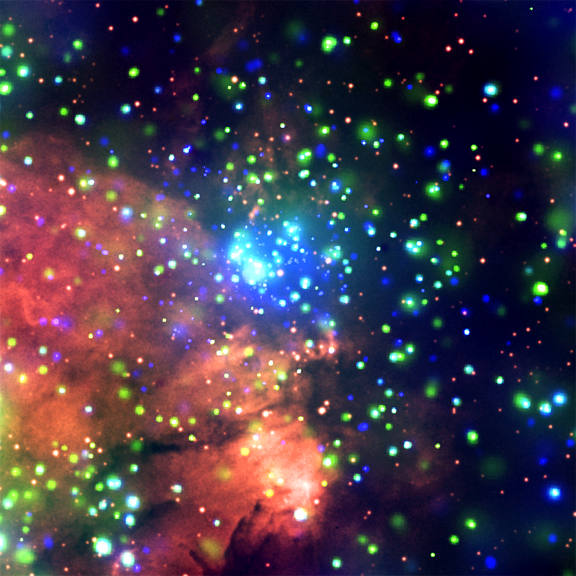
 Credit: NASA/CXC/Penn State/L.Townsley et al.; Optical: Pal Obs. DSS
Credit: NASA/CXC/Penn State/L.Townsley et al.; Optical: Pal Obs. DSS
New
The arms of spiral galaxies are places full of gas and dust where new stars form. Because of the high gas and dust densities the process of star formation can be hidden from the prying eyes of astronomers. X-ray emission is one good way of studying star formation since X-rays, produced by young active stars, can penetrate through huge amounts of obscuring material. The X-ray image of the young molecular cloud complex W3 obtained by the Chandra X-ray observatory is a good case in point. W3 is located in the Perseus arm of the Milky Way, and is extremely young (only a few hundred thousand to a few million years old). The image above is a composite X-ray image and optical image of the cluster. Low energy X-ray emission is shown in green, while harder X-ray emission is in blue, while the optical image is shown in red. The X-ray image shows many hundreds of new stellar X-ray sources in the central part of W3. Astronomers suspect that the huge amounts of star formation in W3 might be influenced by a nearby "superbubble" expanding into the W3 molecular cloud.
<
HEA Dictionary ● Archive
● Search HEAPOW
● Other Languages
● HEAPOW on Facebook
● Download all Images
● Education ● HEAD
>
Each week the HEASARC
brings you new, exciting and beautiful images from X-ray and Gamma ray
astronomy. Check back each week and be sure to check out the HEAPOW archive!
Last modified Tuesday, 27-Feb-2024 10:10:19 EST


